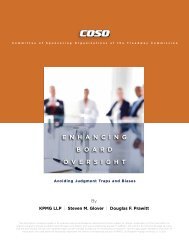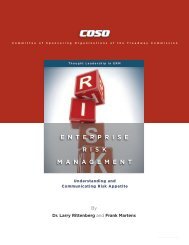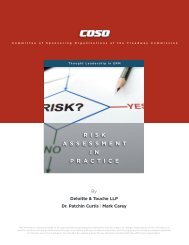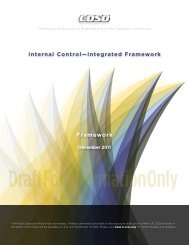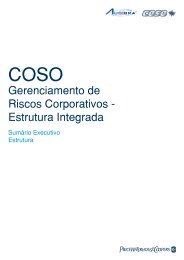Embracing Enterprise Risk Management: Practical - Coso
Embracing Enterprise Risk Management: Practical - Coso
Embracing Enterprise Risk Management: Practical - Coso
You also want an ePaper? Increase the reach of your titles
YUMPU automatically turns print PDFs into web optimized ePapers that Google loves.
Example Strategic <strong>Risk</strong> Profile<br />
Thought Leadership in ERM | <strong>Embracing</strong> <strong>Enterprise</strong> <strong>Risk</strong> <strong>Management</strong>: <strong>Practical</strong> Approaches for Getting Started | 7<br />
Strategic <strong>Risk</strong> Description of <strong>Risk</strong> Likelihood impact Velocity Readiness Priority<br />
Operations Supply Chain Disruptions;<br />
<strong>Risk</strong> Product Liability Events Low High High 1<br />
Reputation Damage to reputation caused by<br />
<strong>Risk</strong> company actions and/or partner actions Medium High High 2<br />
Information Liability to achieve objectives because<br />
Technology <strong>Risk</strong> of failures of enabling technology Medium High High 3<br />
<strong>Risk</strong> 4 4<br />
<strong>Risk</strong> 5 5<br />
Step 7.<br />
Develop the next Phase of Action<br />
Plans & Ongoing Communications<br />
The implementation of ERM is an evolutionary process that<br />
takes time to develop. In the spirit of continual improvement,<br />
once the initial ERM action plan has been completed, the<br />
working group or risk leader should conduct a critical<br />
assessment of the accomplishments to date and develop a<br />
series of action plans for the next stage of implementation.<br />
Following the incremental approach, the leader should identify<br />
next steps in the ERM roll-out that will foster additional<br />
enhancements and afford tangible benefits as a result.<br />
iii. Continuing ERM implementation<br />
The intent of this paper is to provide a simple illustration of<br />
ways to launch ERM. It represents a beginning, not an end<br />
point. An organization following this incremental approach<br />
to achieving ERM benefits will have taken a significant first<br />
step toward ERM and have a much better understanding of<br />
where it is headed and what needs to be accomplished next.<br />
To lay the groundwork for ERM success, an organization<br />
should first establish its initial ERM process as an ongoing<br />
and important element that will assist in achieving business<br />
objectives. Given the evolutionary nature of ERM and<br />
the dynamic nature of risk, the ERM process must be<br />
ongoing and not viewed as a one-time event. The initial<br />
risk assessment process will need periodic updating and<br />
the organization will need to be attuned to the need to<br />
identify new and emerging risks. A solid foundation for risk<br />
The completion of the initial ERM action plan is also an<br />
opportune time for the risk leader and the ERM working<br />
group to convey the status and benefits achieved to the<br />
board of directors and senior management. The risk leader<br />
should also consider what types of ongoing education<br />
offerings and communications should be deployed across<br />
the organization to continue to strengthen the organization’s<br />
risk culture and ERM capabilities.<br />
management should be established and nurtured. Ongoing<br />
communications from directors and senior management will<br />
serve to reinforce and nurture the risk management culture.<br />
Once ERM is off the ground, the organization can look for<br />
additional ways to expand the implementation of ERM<br />
across the organization. It should also be aware that, while<br />
tangible risk processes may have been implemented during<br />
this initial phase of ERM deployment, the processes may<br />
likely fall short of a complete ERM process and need to be<br />
enhanced. Accordingly, the organization’s risk management<br />
leaders need to continue to drive further development and<br />
maturity of the risk management processes. They need to<br />
pursue levels of risk management maturity that reflect the<br />
components of the COSO’s <strong>Enterprise</strong> <strong>Risk</strong> <strong>Management</strong> -<br />
Integrated Framework.<br />
w w w . c o s o . o r g




